One of the best things about working in the field of hand-knit design is that it really is an industry which abounds with good eggs. In my view, two of the very best eggs around are Gudrun Johnston and Mary-Jane Mucklestone: great friends, talented designers, and Shetland enthusiasts. Gudrun spent her early years in Shetland, and the island’s textile heritage and culture exerts a strong influence on her beautiful, contemporary designs. Mary Jane, meanwhile, is the author of several carefully-researched books about colourwork traditions, and her books on Fair Isle and Scandinavian motifs sit on thousands of knitterly bookshelves all over the world. Sharing their expertise and passion for Shetland and its textiles, Gudrun and Mary Jane now organise and lead tours of the islands, which regularly sell out as soon as they are advertised. On Gudrun and Mary Jane’s tours, visitors take classes with world-class designers such as Hazel Tindall, learn about the wool industry from experts like Oliver Henry, and discover the landscape on foot as they hike with Mary Jane. I am a huge fan of everything Gudrun and Mary Jane do, and I caught up with them for the latest in my series of woolly conversations associated with the publication of our new book, Shetland Oo.
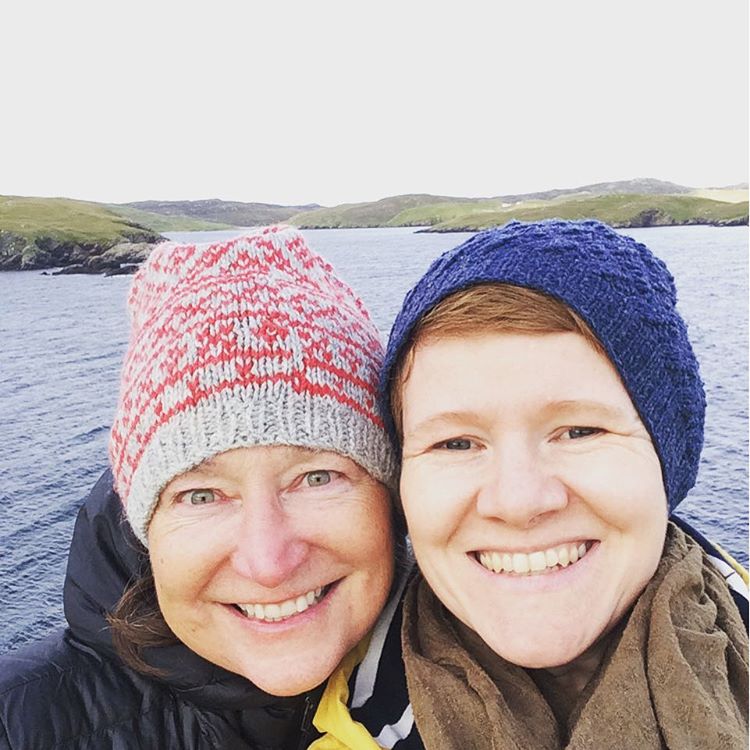
(Gudrun and Mary Jane)
KD: Hi Gudrun! Thanks for joining us today. I know you feel like me that Shetland is a truly wonderful place. I wonder if you could put into words what is about these northerly islands that so inspires you?
GJ: The thing that always strikes me when first returning to Shetland is the epic quality of the light and how it constantly changes the hues and palette of the landscape. You can be driving the same route on the same day and experience very different views. It never fails to take my breath away! Those vistas offer up an incredible sense of space and calm for me. I feel that my mind can think in an uncluttered and calm way and that probably allows the inspiration to seep in. Of course on a more tangible level there are so many opportunities to see actual textile and knitwear designs, be they traditional or contemporary. I never fail to be impressed and in awe of those skills and ideas.
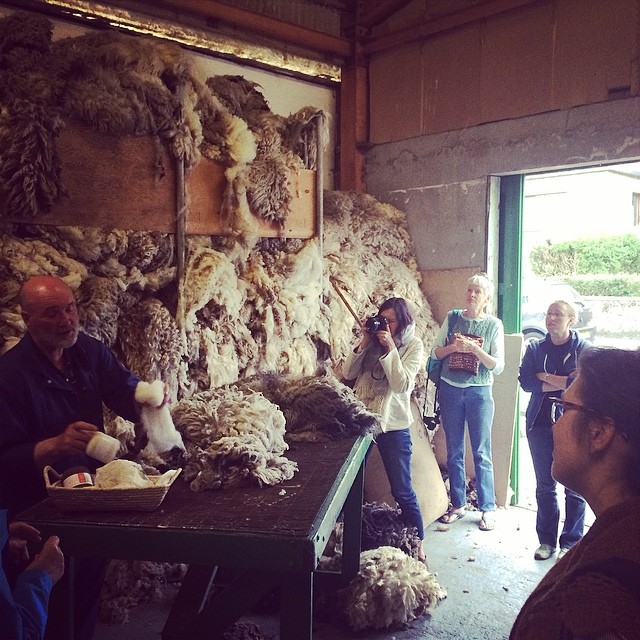
(Oliver Henry sorting and grading wool at Jamieson and Smith)
KD: What do you think an interested first-time visitor to Shetland would enjoy most about one of your tours?
GJ: Aside from the obvious wooly places of interest that we visit I think that one of the main things our tours provide is a very personal experience of the islands and specifically its people. We offer ample opportunities for the group to spend quality time with those working in the textile industry in Shetland. This might come in the form of tea and cake at the home of Sue and Ronnie of Uradale farm or dinner with Hazel Tindall and Elizabeth Johnston at our accommodations at Burrastow. Our participants take so much away from these interactions and leave the tour with a strong and lasting impression of what it means to live in Shetland.

Talented Fairisle knitter, Pearl Johnson, shares her skills and expertise (and is that a Caller Herrin hat I see?)
KD: One of the great things about running a small craft-related business is that you are constantly turning your hands (often literally) to new things to accommodate new ideas and new directions. Did you find you had to learn new skills when developing your trips and tours? What has this new venture taught you?
GJ: I definitely had to up my organizational skills and plan way ahead of what I normally do. I didn’t quite anticipate the amount of work it takes to put something like this together. However it turns out I really enjoy the planning and bookkeeping involved! Coming up with the itinerary and deciding how the week will be divided up is a lot of fun too. It’s definitely a different hat to wear but one that gives me a lot of pleasure. It has been so rewarding to see a group of (mostly strangers) with a shared passion come together and form significant friendships while at the same time fall deeply in love with Shetland. Meeting people who are often traveling solo for the first time and potentially really out of their comfort zone is a reminder to me that I need to push myself to try new things too!
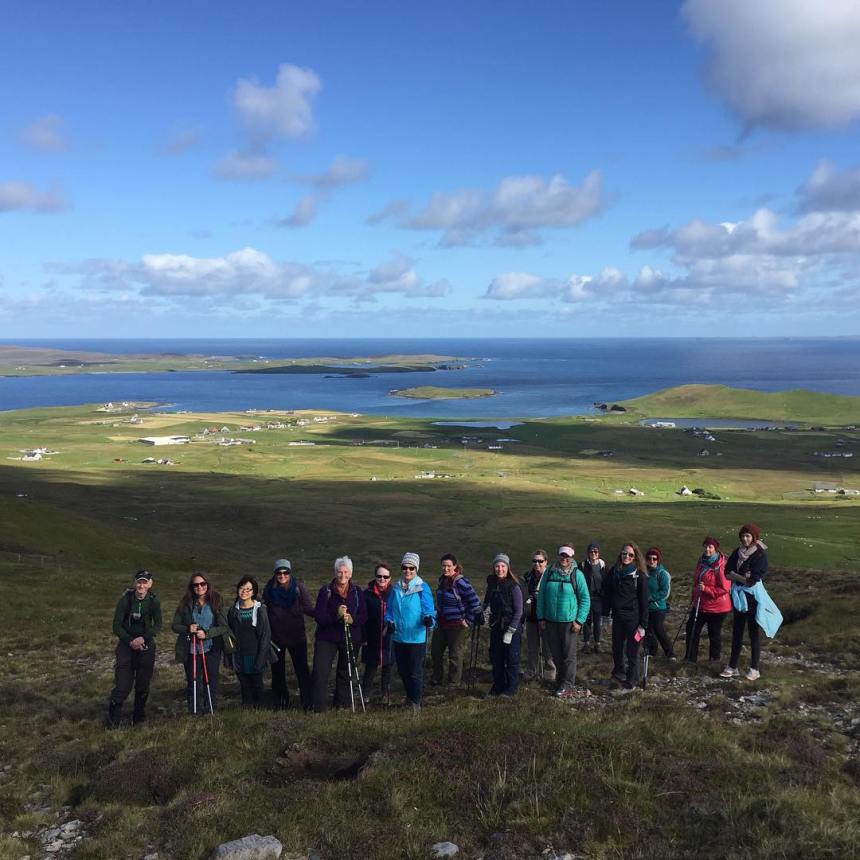
(enjoying a Shetland walk)
KD: Shetland is full of inspiring artists and craftspeople, and one of the things I love about your tours is the way you involve so many different local businesses in what you are doing. Can you tell us a little about the different range of classes and visits you have planned for next year’s trips to Shetland?
GJ: We definitely have some standard visits and classes that will always make it into our itinerary. Taking a dyeing workshop with Niela Nell is something that we want every visitor to experience! However we like to mix it up each year and we are always adding different classes and visits. There are often new textile exhibitions for us to experience and these can take us to new locations. Last year we went to Whalsay for the first time to visit the fabulous “Fair Isle Through The Decades exhibition”. I can’t give away too much about the upcoming trips but one new visit we are planning is to the weaving studios of GlobalYell.
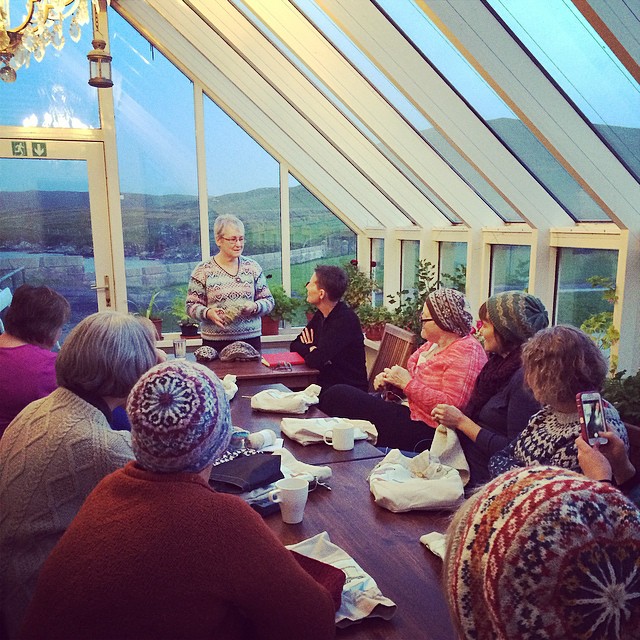
(the inimitable Hazel Tindall taking a class at Burrastow House)
KD: You know I’m a big fan of your designs. You have a really thoughtful approach to creating knitwear, and one of the things I love most about what you do is your ability to take an element of traditional Shetland style, and spin it in a completely contemporary way (often apparently effortlessly!) Can you share any tidbits of the designs you are working on at the moment, and what we might expect from you in the coming months?
GJ: Well currently I am in the early stages of putting together a third Shetland Trader collection. This time I am going back to it’s roots and looking at the designs my mother produced when she ran the Shetland Trader as a ready to wear knitwear business. She too had an ability to take the traditional and reformat it for what was then a 1970’s audience. Many people in Shetland remember the impact her designs had. Over these last few years I have had the good fortune to come across some of those very original pieces and my plan is to recreate them adding some of my own modifications. For the most part patterns were never written for these garments. Despite being designed about 40 years ago they still hold great appeal to today’s knitters. Other than that everything else I am working on is top secret but will be revealed over the course of 2017!!
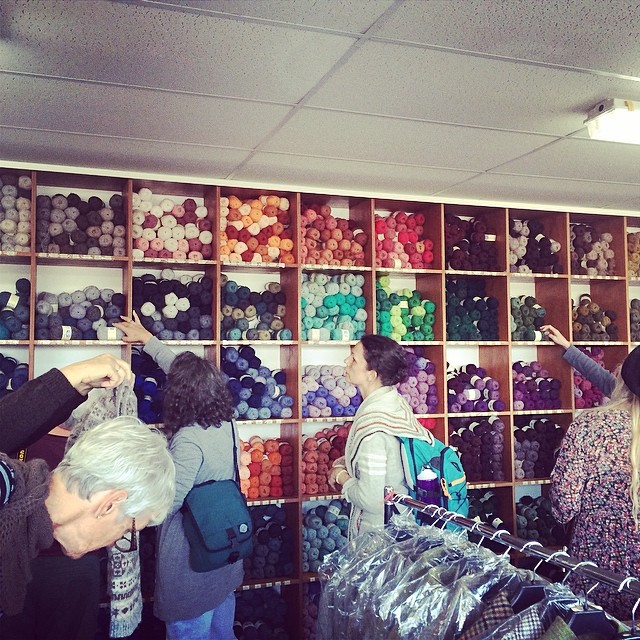
KD: Thanks Gudrun!
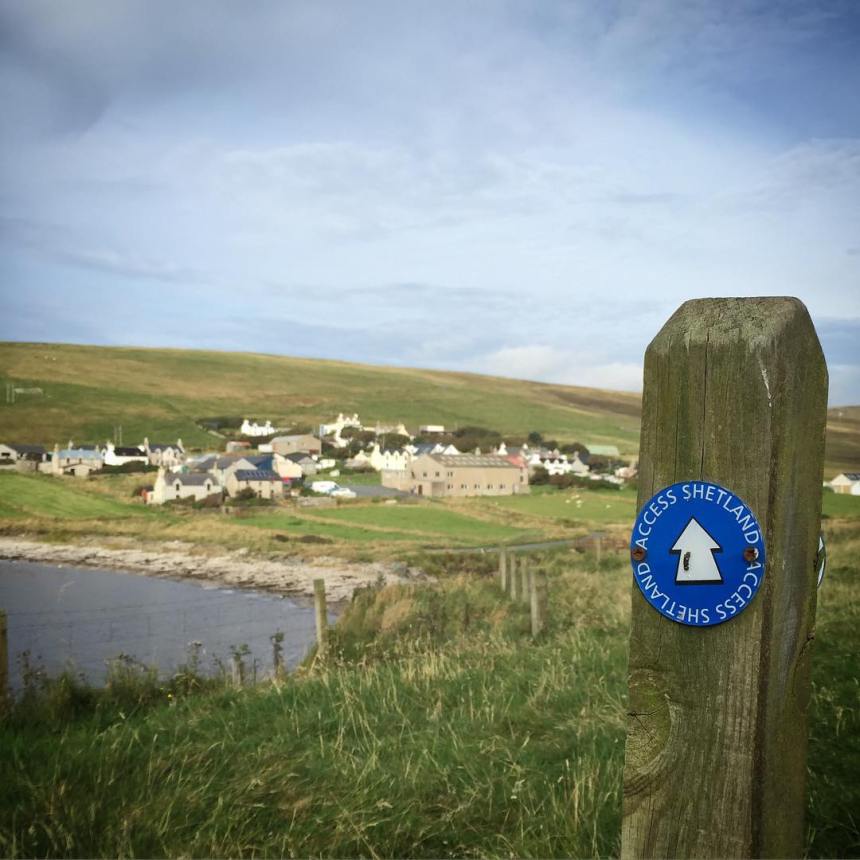
KD: Hi Mary Jane! I know you enjoy the great outdoors, and, like me, are a big fan of walking / hiking. I fell in love with hill walking when I visited the Lake District as a teenager. Can you tell us a little about where your love of walking came from?
MJM: Strangely hiking for me is relatively new. It helped me navigate an emotionally difficult period in my life where the only thing that seemed to quiet the voices in my head was walking. I lived in one of the most beautiful places on earth, midcoast Maine which has miles and miles of empty woodland trails, often leading up to amazing lookouts where you can see the ordinary world far below, tiny and inconsequential. It’s exhilarating to reach the top, literally leaving your troubles behind.

(Mary Jane enjoying Shetland)
KD: You have travelled (and hiked) all over the world. What’s the most extraordinary walk you’ve taken?
MJM: I could name almost any walk I’ve taken in Shetland – step outside of any door for a million sensory experiences. The touch of a soft simmer dim breeze or the lash of an angry gale, brilliant day-glow colors of moss and heather shift, muted by grey layers of fog and mist, the song of seabirds welcoming the sun mingled with the crash of the surf, the scent of seaweed, spicy heather or peat crushed underfoot. For a long while, I never saw the island of Foula, it was always veiled by the atmosphere until – there it was – sharp and imposing like the silhouette of a ship thrusting out of the ocean, setting sail for the new world! Clearly my walks allow my imagination to get the best of me which I LOVE! We stumble across abandoned crofts, ancient brochs, rushing peat colored burns and sheep of many colors – so many stories if we allow ourselves to pause and listen. Last summer suffering from jet lag I decided to climb the hill behind Gudrun’s dad’s place, in my PJs because I didn’t think I was going far. But I couldn’t stop, I kept aiming for a farther hill. Cresting a rise I saw below two Shetland ponies, grazing. I carefully approached and when I got very near to them I lay down in the springy heather and rested. Before long my pony friends were munching the heather all around me, snuffling with their hot breath. Magical.
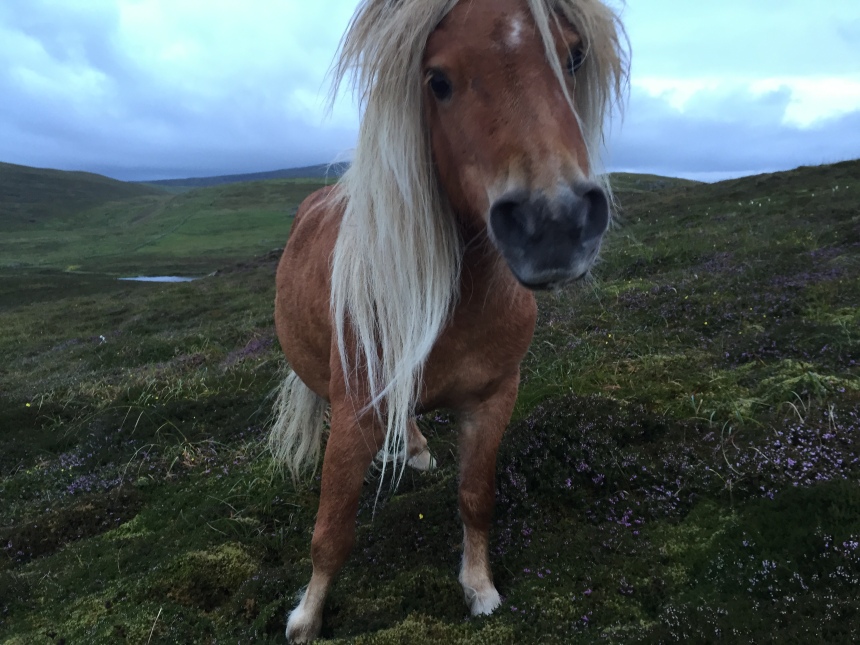
(pony encountered by Mary-Jane on her magical walk in the Shetland simmer dim)
KD: Shetland is a wonderful place to explore on foot. What might a visitor encounter if they joined you on a Shetland walk?
MJM: Walking in Shetland is my very favorite thing to do. Something about heading out on foot in the endless landscape soothes my soul. I’m always at the risk of sounding like a bad poet when I try to explain it, impressions come in fragments and are difficult for me to describe. For one thing the sea is never far, and a glimpse of it feels like a reward or a prize! Every walk will be different, no matter if you take the same one every day. We might see otters or singing seals – they do sing! Really! Miles of dry stone walls, little stone houses with upturned boats as roofs. Inviting white sand beaches that look like The Med. Geological wonders – a tombolo that connects to the isle of St. Ninian’s where silver treasure was found, a beach where two tectonic plates smash together! Lichens, tiny wildflowers, thousands of seabirds, maybe even a puffin! Five exclamation points in one paragraph might seem excessive until you visit Shetland.
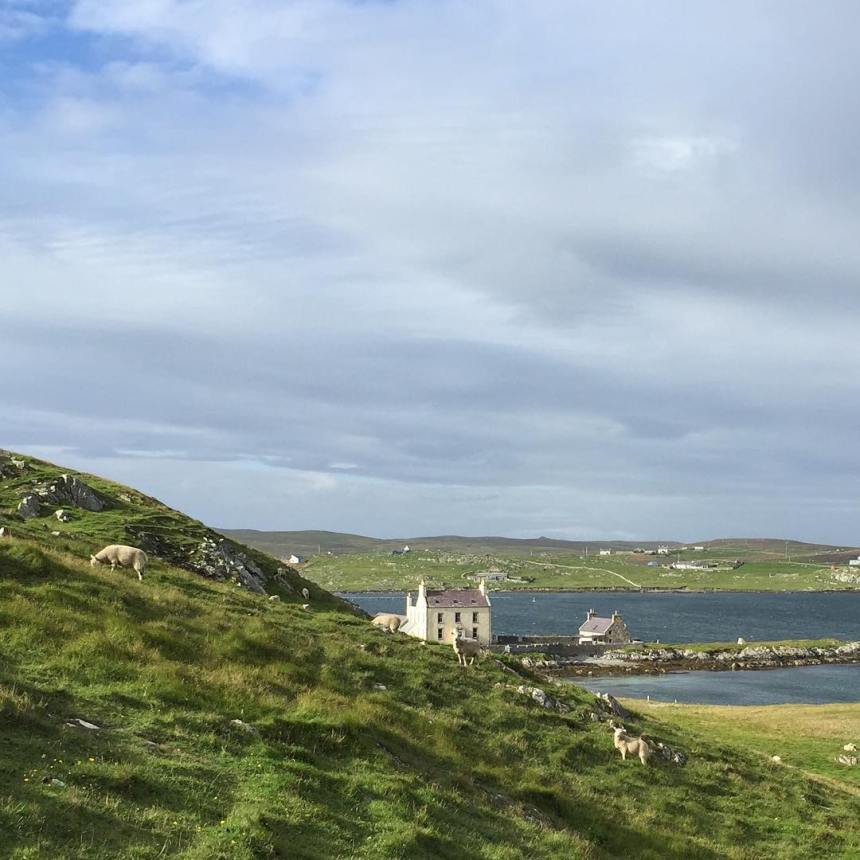
KD: How does the landscape of Shetland – or indeed other landscapes generally – inspire your knitting and designing?
MJM: With Shetland color is the obvious answer. I was knitting with Shetland wool long before I ever visited and I must say I instantly felt at home in the landscape, the colors of the wool, even the impossible seeming ones were right there. I design a lot by deciding what I’d like to be wearing on my adventures, and the changing weather of Shetland is always in my mind…Layers, little accessories – you need fingerless mitts and wristlets all year round, hats and scarves – or maybe a knitted vest is all you might need to ward off the chill. Comfort and joy are essential elements in any garment, and Shetland seem to inspire that.
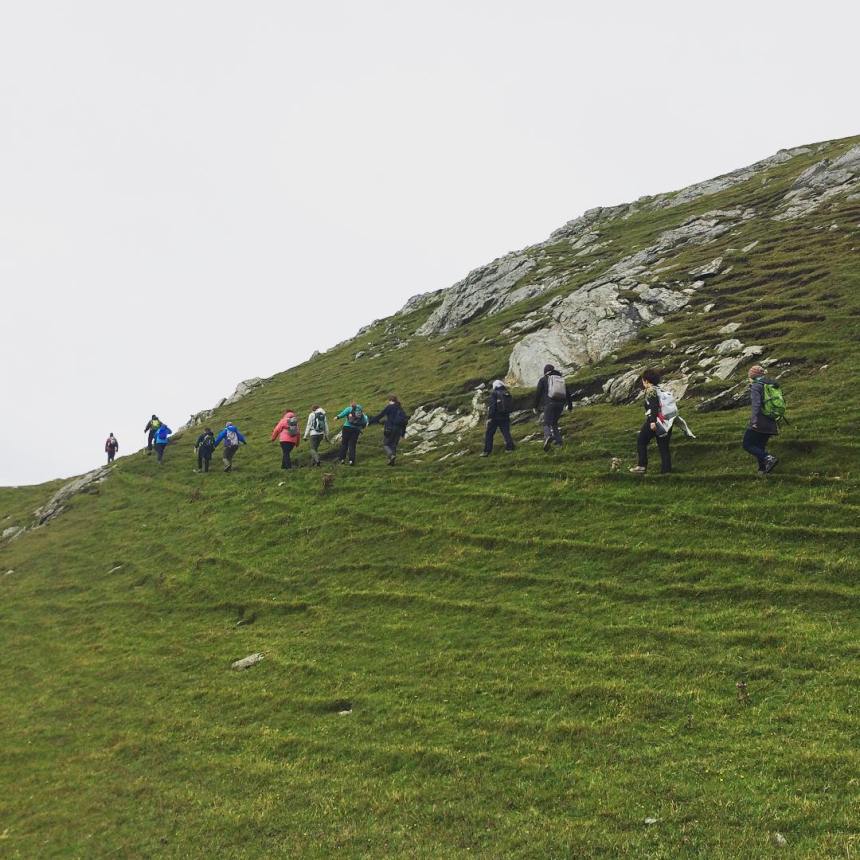
KD: You are a superlative Fair Isle designer, with an incredible sense of colour, and a matchless understanding of the history and practice of Fair Isle knitting in Shetland. I wonder if you have a favourite piece of vintage / historic Fair Isle knitting? Can you tell us a little about it?
MJM: Oh Kate! It is so hard to choose. There are so so many examples. What I love is that the pieces we find in museums are really just “old clothes”, and as old clothes they have so many stories to tell when we study them. I love to see how they are constructed and how they are creatively mended. There is a fair isle jumper in the Shetland museum that was worn by POW Ralph Paterson for nearly 5 years while he was imprisoned in Hong Kong during WW2. Knit by his wife in 1921 in an array of natural sheep colors, it features alternating large and smaller OXO patterns. The Os in the large ones change in every band making it especially interesting, plus the smaller bands don’t match the same way all around but are just lined up with the large Xs down the center front. Her use of the limited sheepy color palette is simply wonderful and she worked the borders in a checkerboard kind of corrugated rib which is immensely charming. As if that weren’t enough, close observation reveals Paterson carefully mended his jumper with whatever scraps of fiber were at hand, reminding me of the lining of bird’s nests. It is poignantly clear how much the jumper acted as a lifeline connecting him to his family and home.

KD: Thanks for joining us today, Mary Jane!
All photos reproduced courtesy of Gudrun and Mary Jane with the exception of final image of Ralph Paterson’s sweater, reproduced courtesy of Shetland Museum and Archives, where it can be seen and studied (Tex 01340)
Shetland Oo: Wool, Textiles, Work is now available from our shop.


Lucky me, I’m signed up for Gudrun and Maryjane’s Wool Week tour- can hardly wait! Meanwhile, it’s all things Shetland, all the time!
LikeLike
:) sweeties. (and eek! we were in jamieson’s choosing yarn!)
LikeLike
Great post, Kate! Hi Gudrun! Makes me wish we could all go on a walk right now, followed up by some knitting, of course! I so want to visit one day. But for now I’ll enjoy the fair isle knitting and dream on…
LikeLike
Great interviews. You can definitely hear the excitement of being in Shetland in their voices.
Wondeful pics, too. Thank you!
LikeLike
Mary Jane’s description of Paterson’s sweater makes me misty-eyed! What a story, what a garment!
LikeLike
Kate your blogs are a wonderful interlude in my days and the makkers you bring us are all so inspiring! Thank you for this fabulous “service” to us all.
LikeLike
Great interview. Thoroughly enjoyed it. Shetland is definitely on my bucket list!
LikeLike
What a great ‘walk’ with these women! Thank you.
LikeLike
Lovely post! Imagine my surprise when I saw myself here pictured with Pearl Johnson. I remember our conversation so well. As with most of my interactions with Shetlanders, I was struck by her kindness and generosity in sharing her vast knowledge (and yes, I am holding my Caller Herrin, my favourite hat!)
To anyone who is thinking of going on a trip with Mary Jane and Gudrun, I say do it!!! One of the best trips of my life!
LikeLiked by 1 person
Wow. Now I’m dreaming of a tour to Shetland. Thank you for the wonderful interviews, and photos.
LikeLike
I am so excited about your new book! I love the book of Haps. I have learned so much about the beautiful Shetland Islands. I would love to learn how to make a fair Isle cardigan. Can you recommend a beginners knitting guide for me?
I was learning to knit one back in 1993 while sitting in my younger brothers hospital room as he lay dying of Aids. When he died, I threw away everything related o the pattern. I am ready to start up again, fair isle knitting, because of your beautiful publications. Thank you💜
My best,
Mary Dean
Portland, Oregon
LikeLike
Your words brought tears to my eyes, Mary. I’m so sorry for your loss and sympathise with how a craft activity can be the source of sadness because of its associations. I hope that, as you learn again, you build up a new store of happy memories through your knitting! I’d definitely recommend Mary Jane’s book on Fairisle motifs, and Hazel Tindall’s video (downloadable from hazeltindall.com) takes you through the steps of making a Fairisle “allover” cardigan from start to finish. If you are interested in other cardigan patterns, I think Susan Crawford’s Bowland is a lovely pattern http://www.ravelry.com/patterns/library/bowland-2 – and I have a slightly simpler pattern which has Fairisle on the body only http://www.ravelry.com/patterns/library/ursula-cardigan. Happy knitting to you! Kate x
LikeLike
An amazing interview. I have so enjoyed all the Shetland posts of late. Wish I could say I will visit there one day but I am doubtful I will so I love hearing and seeing the wonderful photos.
LikeLike
Wonderful post! I was SO fortunate to be part of one of Gudrun & MaryJane’s trips this past August. That’s my group in the photo above captioned ‘enjoying a Shetland walk.’ I’m smack in the middle, turquoise jacket & Peerie Flooers hat. We got to meet so many talented Shetlanders — many of whom are featured in your new book. Besides the wooly-folk, my favorite activity was our hike to Fethaland, where the Atlantic Ocean & North Sea are just a stone’s throw apart. Kudos to Gudrun & MaryJane for introducing people from around the world to the wonders of Shetland.
LikeLike
As always, your writing is such an enjoyable experience! Love the writing and reading of two wonderful designers.
LikeLike
P.S. I look forward to meeting Gudrun and Mary-Jane at Vogue Knitting in January in NYC!
LikeLike
Kate–
I love this series of posts.
My husband and I visited Shetland in September for Wool Week.
We had the good fortune to see many of the places and people mentioned in this post like Hazel Tindall, Niela Nell (I didn’t attend her class but I saw the results–totally amazing!), Ronnie, and Oliver Henry. As New Yorkers, we were touched by their depth of knowledge and openness.
Gudrun and Mary-Jane’s tour sounds amazing.
May I suggest that you interview Anne Sinclair? Her talk on the history of Fair Isle was incredibly instructive.
Happy knitting,
Heidi Cohen
Knitted Yarns
LikeLike
Hi Kate! Your blog gives me a fix for both traditional knitting and the British Isles. Great job! Incredible, actually. Thanks! I’ve been trying to buy the Shetland book but it gives my country as the ABC Isles, and I can’t change it. Any suggestions? Thanks,Sue Penasack
LikeLike
Hi Susan, just email us at info@katedaviesdesigns.com and we can sort out these issues for you
LikeLike